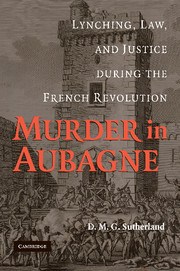Book contents
- Frontmatter
- Contents
- List of Figures
- Preface
- Acknowledgments
- Abbreviations
- Aubagne: An Introduction to the Problem
- 1 Structures and Events
- 2 The Olive Festival
- 3 Aubagne's Universe: Marseille, Aix, and Arles, 1789–1792
- 4 Murders in Provence
- 5 Vigilantism and Federalism
- 6 Federalism
- 7 Terror in a Small Town: Aubagne
- 8 The Revolution of the Antiterrorists: Vengeance, Massacre, and Justice
- 9 The Bande d'Aubagne
- Conclusion
- Appendix
- Sources and Methods
- Index
4 - Murders in Provence
Published online by Cambridge University Press: 13 August 2009
- Frontmatter
- Contents
- List of Figures
- Preface
- Acknowledgments
- Abbreviations
- Aubagne: An Introduction to the Problem
- 1 Structures and Events
- 2 The Olive Festival
- 3 Aubagne's Universe: Marseille, Aix, and Arles, 1789–1792
- 4 Murders in Provence
- 5 Vigilantism and Federalism
- 6 Federalism
- 7 Terror in a Small Town: Aubagne
- 8 The Revolution of the Antiterrorists: Vengeance, Massacre, and Justice
- 9 The Bande d'Aubagne
- Conclusion
- Appendix
- Sources and Methods
- Index
Summary
Some people got away with murder in Aubagne in 1792. And so the town took another step toward the massacres of the Thermidorian period and toward the grande affaire. The most spectacular murder of the revolutionary era in Aubagne took place on 18 September 1792. Shortly after one in the morning, a frenzied crowd, “composed of citizens of each sex and every age,” hanged Joseph Jourdan a former officier ministériel, an official of the court who collected fines, in the public square.
The crisis had begun six hours before when the town council got word that Jourdan was “running the greatest risk [and] that there was the greatest fermentation against him.” Public opinion was “accusing him of the crime of counter-revolution.” Five municipal officers wearing their sashes of office ran to the Bourg du Mouton post where Jourdan was standing guard and escorted him into protective custody at the town hall. The crowd followed them and quickly invested the town hall. While the councillors demanded calm, people shouted one denunciation after another. “From time to time, frightful cries both from inside and outside troubled the town hall and forewarned a rage, a fury, and an impatience that was almost impossible to contain,” as the usually laconic council minutes put it. The crowd insisted that a proper, legal written denunciation be drawn up, and the councillors, only too happy to stall for time until fatigue overcame the people, went along.
- Type
- Chapter
- Information
- Murder in AubagneLynching, Law, and Justice during the French Revolution, pp. 88 - 121Publisher: Cambridge University PressPrint publication year: 2009

